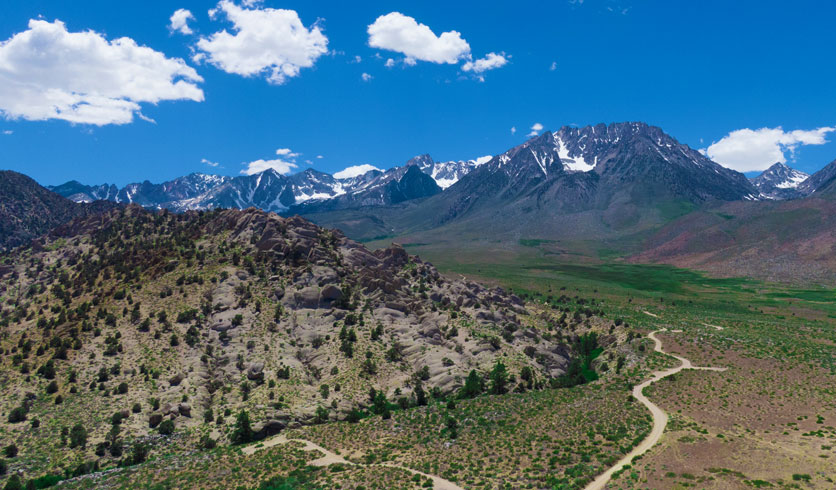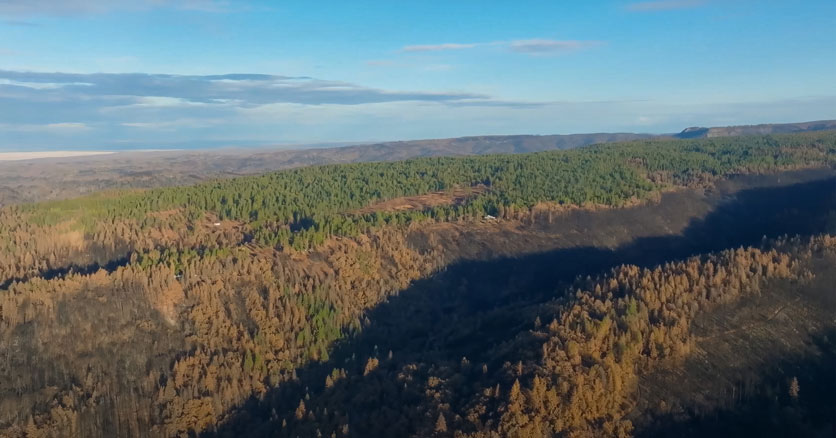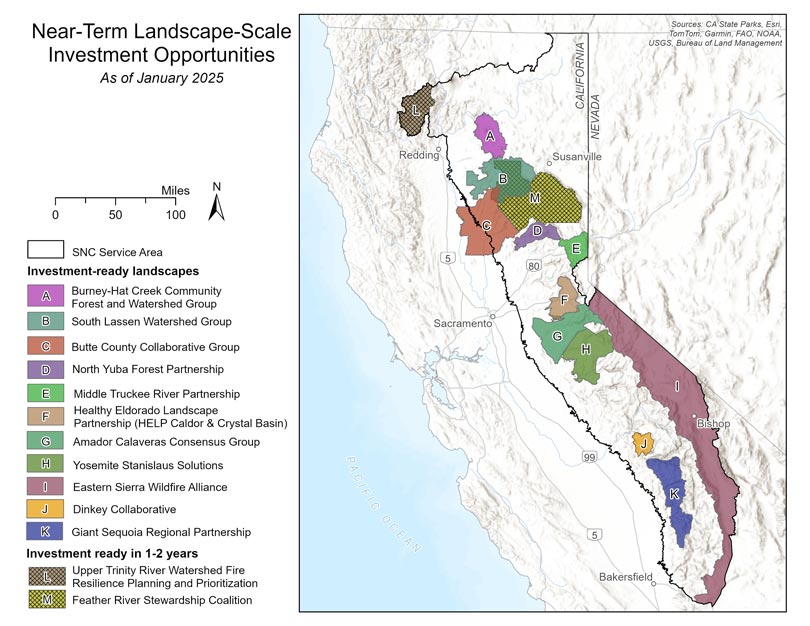A letter from SNC’s Executive Officer

In many ways, 2024 was a time of intense activity for the Sierra Nevada Conservancy (SNC). We distributed our remaining climate and wildfire funding to 21 worthy projects and invested heavily in our partners, providing 27 capacity-building grants through the Regional Forest and Fire Capacity Program. We also launched a tribal capacity building program to help lift up 12 Sierra-Cascade tribes that are reclaiming essential stewardship roles.
It was a year of reflection and planning, as well. We celebrated 20 years of impact that was underscored by the role that recent SNC-funded work played in saving multiple communities from multiple fires during the 2024 fire season. And we looked to the future, adopting a new strategic plan that charts our path over the next five years.
It’s been a big year for the SNC and the communities and landscapes we serve. There is a lot to celebrate, and an ever-growing to-do list for building resilience in California’s Sierra-Cascade.
Projects protect three communities from fire in 2024
The Sierra-Cascade region endured another challenging fire season in 2024. Most of the acreage burned throughout the state resulted from the Park Fire that started on July 24 near Chico, CA. Fueled in part by a record hot summer and red-flag conditions, the fire grew explosively, challenging suppression agencies with a rapidly expanding front. It eventually grew to over 450,000 acres.
The Park Fire burned through Butte County, which has suffered immense losses from a series of large, damaging, and deadly earlier fires, including the 2018 Camp Fire and 2020 North Complex Fire. Like these fires, the Park Fire once again displaced thousands of residents from their homes and left too many families without homes to return to. Unlike recent megafires, not a single life was lost. Neither did whole communities burn to the ground.

In these stark facts, there is reason for hope.
California responded to tragedies like the Camp Fire and North Complex Fire with historic state investments in wildfire resilience. The SNC and CAL FIRE immediately put some of this money to work in areas that would become part of the Park Fire burn area. As a result of these investments, and heroic efforts by emergency responders, residents of the towns of Cohasset and Forest Ranch were able to evacuate safely, and hundreds of homes were saved.
A similar scenario played out on a much smaller scale in Sierra County. There, community leaders came together following the 2020 Loyalton Fire to create a plan to reduce fire risk to the towns of Loyalton and Sierra Brooks. The result was the Smithneck-Sierra Brooks WUI Fuel Reduction Project, which was funded by the SNC in 2021 and nearly completed by fall of 2024. This project proved its worth when the September 2024 Bear Fire started nearby and began quickly spreading towards Sierra Brooks. Fortunately, firefighters were able to use fuel breaks created by the project to contain the blaze just outside of town. Not a single structure was damaged.
Historic budgets fully invested
Beginning in 2020, California policymakers approved a series of climate, wildfire, and natural resource budgets that collectively allocated $136 million to the SNC for local assistance grants. As of December 2024, the SNC has awarded every single penny to meaningful projects throughout the Sierra-Cascade.
Many projects are similar to the efforts that protected Forest Ranch, Cohasset, and Sierra Brooks during the 2024 fire season. Others invested in wildfire recovery, like the Bootsole Project utilizing impacts from the Dixie Fire, or wood-utilization infrastructure to help drive down the cost of future restoration projects, like funding for a sawmill in Nevada County.
The SNC also invested in conservation efforts that align with California’s 30×30 initiative. These grants include, returning land to the Tübatulabal Tribe, protecting biodiversity hotspots in the Upper Trinity Watershed, and expanding migration corridors in Placer County. We also took steps to promote responsible public access, whether by investing in efforts like the Sierra Buttes Trail Stewardship’s Connected Communities project, or improving facilities at a heavily used hot-spring on California’s east side.
Even amid a historic funding cycle, the SNC was forced to turn away more good projects than we funded. The SNC had an 88 percent oversubscription rate for our grant programs. We received $257 million in requests for the $136 million we had available for grants. As we turn towards more austere budgetary times, the gap between California’s wildfire, climate, and outdoor access goals in the Sierra-Cascade and available funding remains large.
Large landscapes ready for resilience
In 2023, the SNC made the inaugural award in a landscape grant pilot program that is testing new ways of pooling and deploying funding at a scale that matches modern megafires. This award, to the Healthy Eldorado Landscape Partnership, is restoring resilience across the Crystal Basin.
Selecting the first landscape grant recipient also revealed an exciting result— other areas in our service area where landscape-level funding could be put to work immediately. Each area is home to a broad-based, land-management collaborative that has adopted a clear, strategic approach supported by a portfolio of shovel-ready and planning projects. As a result, these landscapes are primed for large investments of restoration funding. They are ready for resilience.

In November, voters passed the Climate Bond (Proposition 4) financing $10 billion for water, wildfire prevention, and protection of communities and lands. This includes $81.5 million for the SNC, and additional funds to the California Natural Resources Agency, including $170 million targeted for landscape-level investments that lead to regional resilience.
We know this funding alone won’t be enough to fully restore every ready landscape in the Sierra-Cascade and we recognize that there are pressing climate-resilience needs in other parts of California, as well. Still, this infusion of funds gives us hope that we can continue to deliver results despite leaner state budgets.
Investing in our partners and tribal equity
Our work here at the SNC depends on a network of local partners willing and able to plan, permit, and implement work on the ground. In 2024, a block grant from the Department of Conservation’s Regional Forest and Fire Capacity Program to the SNC allowed us to invest nearly $9 million in 27 of our local partners.
These entities range from county governments and sophisticated collaboratives working on large landscapes, to a California tribe looking to reclaim its place as steward of its ancestral lands, to a local fire-safe council looking to transition from an all-volunteer workforce. Each is an essential contributor to regional wildfire resilience.
As we invest in the next generation of regional stewards, the SNC is committed to being a true partner to the Sierra-Cascade’s many tribal nations. Governor Newsom’s official state apology to Native Americans recognized and expressed regret for the role of past state actions in dispossessing and disempowering tribes. At the SNC, we hope this moment marks a lasting turning point in California-tribal relations.
For our part, I’m proud to share the SNC created a tribal-capacity program in 2024. Beginning in early 2025, representatives from 12 Sierra-Cascade tribes will participate in a series of paid trainings and knowledge-sharing opportunities that seek to level the playing field for tribes to participate in state-sponsored landscape restoration activities. The curriculum will cover a range of topics from project management, grant administration, contracting, and other skills tailored to the needs of this pilot cohort. It’s a small, but important, step toward equity.
Celebrating 20 years of impact
We started the year by celebrating the 20th anniversary of SNC’s creation at our 2024 Watershed Improvement Program (WIP) Summit in Sacramento. That event featured speakers who shared how the SNC has made good on the bi-partisan promise of our founding charter to support the environmental, economic, and social well-being of the Sierra-Cascade, for all Californians.
We heard many stories of SNC’s impact, including how Pine Ridge Elementary School was saved from a damaging megafire, the return of sacred lands to the California Tübatulabal Tribe, and how small state investments in conservation easements on Cinnamon Ranch in Inyo County created positive economic effects that reverberated throughout Bishop and surrounding areas. These stories, and many more like them, are featured in a special 20th Anniversary Impact Report. If you haven’t already, I invite you to read this report and, like me, become inspired by what’s possible when we work together across jurisdictions and partisan lines.
Best of all, we celebrated these achievements with the people who made them possible, both the public servants who worked to establish the SNC, and the many regional partners who helped turn California’s policy goals into projects that changed lives and protected landscapes.
Recommitting to the next five years
Our Strategic Plan, which the SNC Governing Board adopted at our June 2024 board meeting, states plainly: “Building resilience for the landscapes and communities of California’s Sierra-Cascade is at the heart of everything SNC does.”
Resilience is something the Sierra-Cascade knows a bit about.
After a decade defined by climactic extremes and record-breaking wildfires, much of our service area has found itself bouncing back from one disaster to find a new twist awaits it around the next corner. Summers with record-breaking wildfires flip to winters with record-breaking rain and snow events. Pandemic-induced isolation and closures of public lands turned into long months of pandemic-influenced overtourism and shifting demographics with yet unknown regional consequences.
In the hardest hit parts of our service area, communities and natural landscapes are still recovering. For the burned towns and landscapes denuded of trees during large, high-severity megafires, recovery will take generations. So, too, will the “lucky” people and places that remain unburned, but depend on these landscapes for livelihoods, recreation, and identity. Building resilience in these locations is more urgent than ever.
Our Strategic Plan recommits us to that task via four regional goals: Healthy Forests and Watersheds; Resilient Sierra-Cascade Communities; Sustainable Recreation, Tourism, and Equitable Outdoor Access; and Conservation and Stewardship of Natural and Working Lands. It also recommits us to and improves upon SNC’s strategy for advancing these goals throughout the Sierra-Cascade.
Over the next five years, you can count on SNC’s area staff to be present in regional communities—showing up, listening, and when able, responding to local needs. The SNC will be working hard to secure funding to invest in every stage of the life of a project that are meeting critical needs, while we simultaneously invest in our local partners who make those projects possible. And we’ll almost certainly try something new, and tell you all about it, too, because innovating and storytelling is part of how we work.
So, here’s to the challenges and opportunities ahead and here’s to you, too. Because if you’re reading this, the odds are good you are in it with us—working together on the ever-growing, ever-changing tasks of building resilience in California’s incredible Sierra-Cascade.
Thank you for your continued support of the SNC and the Sierra-Cascade.
Angela Avery
Executive Officer,
Sierra Nevada Conservancy
